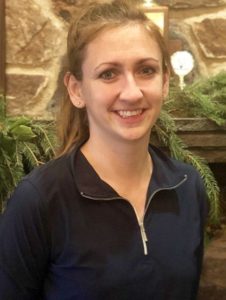The test of a professional golfer

The 7th hole at Ocean Pines GC, one of two locations on the Delmarva Peninsula where the PGA’s Playing Ability Test is administered each year
January 14, 2022
Over 28,000 men and women are members of the Professional Golfers’ Association of America.
Most are club pros, but others work in related activities such as resort managers or club manufacturer representatives.
As with many such organizations, the now century-old PGA developed admission standards for prospective members. Those standards changed as times or conditions warranted.
For several decades, potential golf pros went through an apprenticeship, like those used for plumbers, electricians, and other skilled trades. More recently the PGA offers an internship program, where work experience is combined with formal education requirements.
The current system offers two paths toward obtaining PGA Class A status – the Professional Golf Management Associate Program and the Golf Management University Program.
The PGM Associate system is similar to the old apprenticeship arrangements. Aspiring pros typically work at golf courses and complete online or direct attendance training sessions.
Passing a qualifying test is required. This includes the purchase and review of five qualifying level courses as detailed at the PGA.org website: Introduction to the PGM and the Golf Profession, PGA History, PGA Constitution, Rules of Golf, and Career Enhancement. Associates must also complete three levels of experience and education milestones within 9 years of their starting date at the first level.
The PGM University program emphasizes college classroom training, with scheduled internship work activities interspersed between semesters before the student earns formal PGA status.
Assistant pro Michael Mikuta at Bayside Resort is taking the PGM Associate route. The 2020 University of Delaware graduate joined the Bayside staff last summer in a part-time role and began full-time employment at the Selbyville course Jan. 1.
Bayside Director of Golf Bob Crowther oversees Mikuta’s work experience, as he has for many assistant golf pros during his long career. Crowther said he makes sure his assistants are “exposed to everything. They shouldn’t be pigeon-holed, not stuck in one place. It’s important to offer the widest scope, from merchandise training, cart repair, and helping the course superintendent.”
“We try to include our assistants in all club functions – the whole gamut,” Crowther said.
William “Billy” Dillon is the Associate Professor and Director for the University of Maryland – Eastern Shore’s PGA Golf Management Program, in Princess Anne, MD. Dillon said about 40 students are currently working toward their PGA status at the university.
At UMES, successful graduates earn a B.S. in Hospitality and Tourism Management. While earning the necessary scholastic credits, they must also complete sixteen months of a “structured internship experience,” Dillon said. The internship and credit requirements take four and a half years to complete.
The internships typically occur at golf courses in scheduled blocks. Many participating clubs or resorts are located throughout the Delmarva Peninsula, while others are elsewhere, such as Wild Dunes Resort in South Carolina.
Locally, UMES has official golf development and practice partnerships with Great Hope Golf Course and Nutters Crossing Golf Course, both near the University campus. The program is also a major source of athletes on the UMES men’s and women’s golf teams. Dillon is the head coach for both squads.
In addition to the usual admission standards for UMES, enrolling in the PGM program also requires a golf handicap index of 12.0 or lower.
There is a very good reason for this, and it has to do with the most important hurdle a potential golf pro must leap over on the way to their chosen career: The Professional Ability Test, or PAT.
Both paths to PGA status include this requirement. A passing score must be reached within an eight-year time frame.
To take the PAT, applicants must provide current proof of a handicap index of 10 or less.
The test requires 36 holes of golf completed in one day, with a total score within 15 shots of the course rating. For example, if the course rating is 71.0, the target score becomes 156. To register as an Associate, players must post an 18-hole score equal to or below the PAT target for 18 holes plus 5 strokes. In this example, one 18-hole round needs to be 84 or below, which adds to the pressure.
Dillon said the UMES program requires students to pass the PAT by the end of their junior year. For those who begin the program with the maximum 12.0 handicap, this means they must lower their index by at least 2.
However, the PAT’s effective minimum handicap requirement is even lower.
At first blush, the test’s 15-stroke cap on 36 holes translates to a 7 or 8 “handicap” for each 18. The reality is very few 7 or 8 handicappers can match their handicap index in two consecutive rounds, and especially on the same day. That is because the USGA handicap index calculation uses the best 8 of the last 20 scores, reflecting how you play your better rounds, not your actual average, which is typically about 3-4 strokes above it.
For the PAT, therefore, a maximum handicap index of 4.0 is probably a better indication of your actual chances to pass it.
As Dillon said in a recent interview, “Sometimes we have to have a heart-to-heart talk” with program participants whose actual playing abilities are not quite good enough.
NOTE: This is the first of a 3-part series.
DSGA merges with Golf Association of Philadelphia
Cape Region golfers who maintain an official handicap index through their golf clubs’ affiliation with the Delaware State Golf Association will see something different the next time they post a score – the official logo of the Golf Association of Philadelphia.

Laura Heien
The oldest such association in America recently merged with the DSGA. Laura Heien, the DSGA’s executive director for the last three years, will stay with GAP as the Director of Delaware Golf, part of the 20-person staff servicing the member clubs.
Both organizations provided handicapping, tournament scoring, and course rating services to member clubs, and organized and ran sanctioned golf tournaments. The newly expanded GAP will now have a membership of over 90,000 golfers from parts of four states, with nearly 200 event days annually.
In the press release announcing the merger, DSGA President Bob Strong said, “We look forward to partnering with GAP (Golf Association of Philadelphia) to advance golf in Delaware. We are excited that Laura will continue to manage Delaware golf events for GAP and believe the experience will be positive for Delaware golfers.”
Heien said, “It’s an exciting opportunity for our golfers. There will be new events, but our Delaware classics will remain.” She noted that member play days at GAP clubs will now be open to DSGA members, in addition to more area championships in several categories, including junior tournaments.
GAP’s geographical reach extends to Cape May County, which may tempt Cape Region golfers to make the ferry trip to test their skills at South Jersey events.
Handicap and tournament management services will remain the same, with current DSGA members continuing to use their current GHIN numbers.

